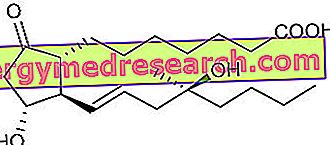Definition
Otitis is defined as inflammation of the ear, generally infectious. It is good to distinguish more forms of otitis:
- Internal otitis: the inflammatory process involves the inner ear
- Otitis media: the infective insult affects the middle ear. Its acute variant is the most common form of otitis in young children.
- External otitis (otitis of the swimmer): inflammation involves the external auditory canal with possible involvement of the tympanic membrane.
- Myringitis: inflammation is limited to the tympanic membrane.
Causes
Most often, otitis media is the consequence of bacterial infections, often supported by pathogens such as Haemophilus influenzae, Moraxella catarrhalis, Streptococcus pneumoniae ; the origin of otitis externa is different, the cause of which often resides in fungi or pathogens that proliferate in damp places (eg swimming pool).
Symptoms
Otitis is always accompanied by inflammation and pain, whose intensity is proportional to the damage caused by the pathogen: auricular pain to the touch (otitis externa), emission of purulent material from the ear canal associated with pain (otitis media), sore throat, fever, low-grade fever, stuffy nose, cough.
- Complications: perforation of the eardrum (due to pus accumulation), impaired hearing, itching in the ear, tinnitus.
Otitis can degenerate into labyrinthitis, an inflammation of the labyrinth that can lead to an alteration of balance and hearing, always accompanied by vertigo, dizziness and confusion.
Information on Otitis - Otitis Treatment Drugs is not intended to replace the direct relationship between health professional and patient. Always consult your doctor and / or specialist before taking Otitis - Otitis Treatment Medicines.
drugs
Since otitis depends on a bacterial or viral infection, the drugs of choice are antibiotics and antivirals, whose action is directed directly against the responsible pathogen.
In the case of secretory otitis media (with emission of fluid from the ear), the antibiotic may not be sufficient to reverse the disease: in this case, the doctor may advise the patient to undergo a procedure that consists of draining the accumulated liquid inside the middle ear.
It is also possible to take drugs to control pain, fever and to speed up the healing time of the disease: in this case, the patient can take analgesics, local or systemic. It should be emphasized that the administration of NSAIDs or steroids is not useful for eradicating the pathogen, rather it is only recommended for pain relief.
There are other non-pharmacological strategies that can act as completion (not substitution) for drugs: the application of hot compresses directly on the ear helps to remove the pain, albeit temporarily.
Pain control therapy for the treatment of otitis:
- Paracetamol or acetaminophen (eg tachypirina, Acetamol): the administration of this drug is useful for lowering fever, a typical symptom that generally accompanies otitis. Paracetamol is administered at a dosage of 325-650 mg per day every 4-6 hours; alternatively, take 1 gram every 6-8 hours. The drug can also be administered intravenously: 1 gram every 6 hours or 650 mg every 4 hours for adults and adolescents weighing more than 50 kilos: if the patient weighs less than 50 kilos, give 15 mg / kg every 6 hours or 12.5 mg / kg every 4 hours.
- Ibuprofen (eg. Brufen, Moment, Subitene): to alleviate the pain associated with otitis, it is recommended to take 200-400 mg of drug orally, every 4-6 hours, as needed. In extreme cases, the drug can also be administered intravenously (eg PEDEA), at a dose of 400-800 mg iv in 30 minutes, every 6 hours, as needed.
- Acetylsalicylic acid (eg. Aspirin, Ascriptin, Aspro): indicatively, take the drug at a dose of 325-650 mg orally or rectally, every 4 hours, as needed. Do not exceed 4 grams per day. Do not give children under the age of 12 suffering from viral diseases to avoid the risk of Reye's syndrome.
- Acetylsalicylic acid and benzocaine (eg Aurodex): this pharmacological association, which combines aspirin with another analgesic, is indicated for the control of pain in the context of otitis. The product should be applied directly into the ear (or both, when otitis strikes both ears). The duration of therapy should be determined by the doctor.
- Hydrocortisone associated with neomycin and polymyxin B (eg Mixotone): it is a pharmacological combination consisting of a steroid drug (hydrocortisone) and 2 active antibiotics. This drug fully exercises its therapeutic activity when applied locally. It is recommended to instill 4 drops of the drug in the ear (or both) affected by otitis externa; repeat the application 3-4 times a day for 10 days. It is also possible to take the two antibiotic drugs without the hydrocortisone: the application is purely local. Apply the product, formulated as a cream or gel, directly into the ear, 2 or more times a day, according to the doctor's instructions. Neomycin is often formulated in association with bacitracin (eg Bimixin): consult a doctor.
Antibiotic treatment to treat otitis: antibiotics can act both systemically and perform their therapeutic activity locally.
- ANTIBIOTICS FOR LOCAL APPLICATION: indicated, in particular, for the treatment of otitis associated with perforation of the eardrum, although they can be used in therapy before proceeding with oral administration of antibiotics.
- Ofloxacin (eg. Exocin, Oflocin): the active ingredient belongs to the pharmacological class of quinolones. For the treatment of acute external otitis, it is recommended to instill 10 drops in the affected ear (or in both when the disease affects both ears), once a day for 7 days. For the treatment of otitis media, maintain the same dosage, but prolong the therapy for 14 days. For children with otitis, the dose should be reduced based on the age and severity of the condition. Consult your doctor.
- Cefixime (eg Cefixoral, Suprax, Unixime): third generation cephalosporin. The drug can be taken by topical application, formulated in the form of drops. Consult your doctor.
- ANTIBIOTICS FOR SYSTEMIC ACTION: to be used generally after a first attempt at antibiotic treatment for topical application. In fact, when the patient does not respond positively to treatment with local-acting antibiotics, it is possible to proceed with oral antibiotics, or intravenous antibiotics in the most serious cases.
- Penicillin G or benzylpenicillin (eg Benzil B, Benzil P): penicillin can be used orally, especially in cases of established streptococcal infection in the context of otitis. In this case, it is recommended to take 250-500 mg of active every 6 hours, for 14 days.
- Amoxicillin (eg. Augmentin, Klavux): it is an aminopenicillin effective for treating bacterial infections in otitis. More specifically, it appears that amoxicillin is particularly effective when associated with clavulanic acid (eg, Amoxicillin and Clavulanic acid Sandoz). In monotherapy, it is recommended to take the drug at a dose of 250-500 mg, three times a day, for 10-14 days. Alternatively, a dose of drug can be administered ranging from 500 to 875 mg orally, twice a day. In association with clavulanic acid, the indicative dose for the treatment of otitis media is to take 250 mg of product per os, every 8 hours, or 500 mg of product every 12 hours for 10-14 days. Consult your doctor.
- Cefuroxime (eg Cefoprim, Tilexim, Zoref, Zinnat): the drug being tested is a second-generation cephalosporin; it can be taken orally (at a dose of 250 mg, twice a day for 10 days) for the treatment of otitis media.
- Ampicillin (eg Ampilux, Amplital, Unasyn): it is recommended to take 500 mg of the drug orally or 1-2 g of drug intramuscularly or intravenously every 6 hours, depending on the nature and severity of the condition.
- Sulfamethoxazole and trimethoprim (eg. Eusaprim oral, Bactrim): the pharmacological formulation consists of two active sulfonamide principles which, acting in synergy, enhance the therapeutic effect, speeding up the recovery time from otitis media. It is recommended to take a dose of drug varying from 160 to 800 mg orally, every 12 hours, for 10-14 days, in full compliance with the instructions given by the doctor.
- Clarithromycin (eg Biaxin, Macladin, Klacid, Soriclar, Veclam): the drug, belonging to the pharmacological class of macrolides, is indicated to treat otitis media when topical antibiotics are not able to benefit the patient. As an indication, take 250-500 mg of active by mouth every 12 hours. The dose of 500 mg, twice a day is indicated to treat otitis triggered by Haemophilus influenzae . Continue therapy for 10-14 days.
- Azithromycin (eg Azithromycin, Zitrobiotic, Rezan, Azitrocin): this drug, like the previous one, belongs to the class of macrolides. The dosage of 500 mg of drug on the first day, followed by 250 mg of drug once a day (for 5 days), is indicated for the treatment of otitis media.



